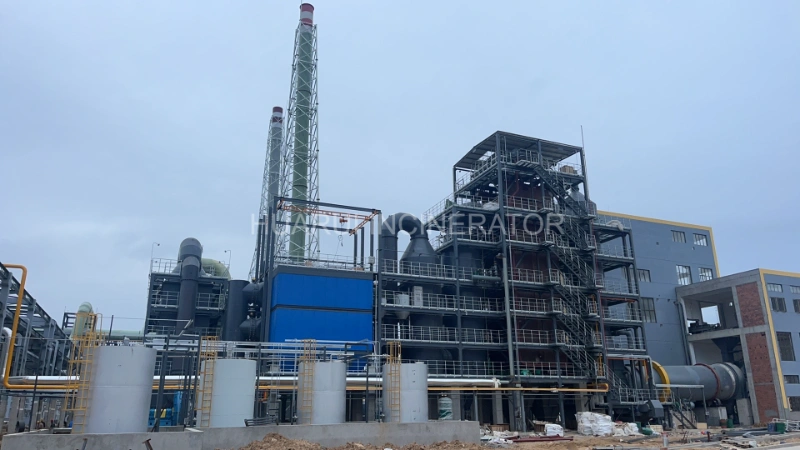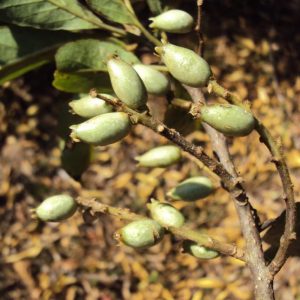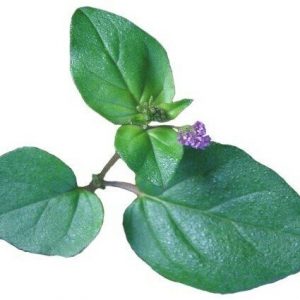Description
Engineering design conditions
The actual solid-liquid ratio of the waste is about 1:1, the processing capacity is about 18,000 tons each year, the comprehensive calorific value is considered between 3500kcal/kg and 4000kcal/kg, the daily processing capacity is 60t every day, and the overload capacity is 20%.
Note: This incinerator shall not be used for incineration and treatment of waste with flame retardant substances, high halide and high salt content.
Main equipment parameters
|
No. |
Equipment name |
Unit |
|
1 |
Feed system |
1 set |
|
2 |
Ash and slag conveying system |
1 set |
|
3 |
Rotary kiln |
1 set |
|
4 |
Second combustion chamber |
1 set |
|
5 |
SNCR denitrification |
1 set |
|
6 |
Waste heat boiler |
1 set |
|
7 |
Cold and semi-dry deacidification tower |
1 set |
|
8 |
Dry powder deacidification adsorption injection device |
1 set |
|
9 |
Bag dust collector |
1 set |
|
10 |
Air and smoke exhaust system |
1 set |
|
11 |
SCR denitrification |
1 set |
|
12 |
Wet deacidification |
2 sets |
|
13 |
Wet dust collector |
1 set |
|
14 |
Flue gas reheat system |
1 set |
|
15 |
Auxiliary wind system |
1 set |
|
16 |
Standby firing system |
1 set |
|
17 |
Compressed air supply system |
1 set |
|
18 |
Electrical instrument automatic control system |
1 set |
Requirements for the technical indicators of the incinerator
|
Name |
High temperature temperature of incinerator (℃) |
Flue gas stay time (S) |
Oxygen content of flue gas (dry flue gas, chimney sampling port) |
Carbon monoxide concentration in the flue gas (mg/m3) (Chimney sampling port) |
Burn effect rate (%) |
Burn to Departure rate (%) |
Hot burning reduction rate (%) |
|
|
Limits |
≥1100 |
≥3.5 |
6-15% |
Mean of 1 hour |
Mean of 24 hours Or daily mean |
≥99.9 |
≥99.99 |
<5 |
|
≤100 |
≤80 |
|||||||
-
Incinerator type: rotary kiln + secondary combustion chamber -
Temperature of the incinerator (secondary combustion chamber): 1,100℃ -
Flue gas residence time: 3.5s -
Efficiency of incineration: 99.9% -
Burning and removal rate: 99.99%
-
Thermal reduction rate of incineration residue:<5% -
Incineration treatment:
|
Project |
Hour processing volume |
|
Solid treatment amount |
500~1500kg |
|
Liquid treatment |
500~2500kg |
|
Total processing volume |
2500kg |
-
Overload capacity: 20% -
Flue gas emission index:
-
Noise emission standards and requirements:
The noise emission standard implements the GB12348-2008 "Environmental Noise Emission Standard for Industrial Enterprises", with 65 decibels during the day and 55 decibels at night.
-
Requirements for discharge of burned residue and fly ash:According to the hazardous waste (inorganic matter) implementation
-
Other solid waste incineration areas except the control room are explosion-proof areas, designed according to explosion-proof requirements.(Control room, power distribution room, on-line monitoring room and other non-explosion-proof, field operation column, field wiring, motor are explosion-proof. EXdIIBT4 Gb IP55 or EXdIICT4 (6) Gb IP65 (determined by explosion-proof environment), indoor IP55, outdoor IP65, anticorrosion grade is WF2. -
The device is designed as indoor explosion-proof area, all instruments explosion-proof grade is EXdIIBT4 Gb IP55 or EXdIICT4 (6) Gb IP65 (determined according to explosion-proof environment), indoor IP55, outdoor IP65, output signal: 4 ~ 20 m ADC (HART).
Process part
Incineration method is a kind of high temperature pyrolysis treatment technology, that is, with a certain amount of excessive air with the treated organic waste in the incinerator, the harmful and toxic substances in the waste are destroyed under 800~1200℃, is a kind of treatment technology that can realize harmless, reduction and recycling of waste at the same time. The purpose of incineration is to burn waste as much as possible. It is to turn the burned substances into harmless and minimize capacity, and reduce the generation of new pollutants as far as possible to avoid secondary pollution. For the incineration of waste, it can simultaneously realize the three purposes of reducing the amount of waste, completely burning down the toxic substances in the waste, and recycling the waste heat generated by incineration.
Incineration is a thermal technology for treating waste through combustion. Combustion is a violent oxidation reaction, often accompanied by heat and heat light, that is, radiation heat, also often accompanied by flame phenomenon, will lead to the increase of the surrounding temperature. There are three main components in the combustion system: fuel or combustible substances, oxides and inert substances. Fuel is an organic substance containing high energy chemical bonds such as carbon, hydrocarbon, hydrogen and hydrogen, after oxidation, which will release heat energy; oxide is an indispensable substance in the combustion reaction, the most common oxide is air containing 21% oxygen, the amount of air and the degree of mixing with fuel directly affect the combustion efficiency; inert substances are not directly involved in the combustion process. The combustion process of combustible substances is more complex, usually composed of heat transfer, such as thermal decomposition, melting, evaporation and mass transfer process.
The specific features and corresponding solutions of this project
Specific features of this project:
This project is a comprehensive treatment project of hazardous waste. According to the characteristics of waste and previous engineering experience, the treatment of such waste requires a multi-functional and adaptable furnace type to meet the incineration requirements;
The design idea of this project:
According to the characteristics of this project, the rotary kiln incinerator is selected, which can burn both solid and liquid simultaneously, especially for the chemical residue, sludge, organic waste liquid, industrial solid waste, etc.. It is the preferred furnace type for the comprehensive industrial waste disposal center. The rotary kiln incinerator is built with thermal insulation brick in the cylindrical metal shell, which is placed horizontally and slightly inclined, and is evenly mixed through the overall rotation of the furnace body and moves to the discharging end along the tilt angle. This incinerator adopts the sequential design of flue gas. Through the rotation of the furnace body, the waste is rolled and stirred continuously to ensure the uniformity of heating, and the residence time of the waste in the rotary kiln can reach 0.5~1 hour, which can ensure the full heating of the waste and the removal of organic matter fully.
At the same time, a secondary combustion chamber is equipped to burn the waste gas generated by the rotary kiln incinerator again at high temperature (1100℃) to ensure the removal efficiency of organic matter. The type is selected according to the use temperature of 1100℃(at least) and the residence time of the flue gas is at least 3.5 seconds. The gas after high temperature purification contains a lot of heat and can be recycled. This project uses flue gas waste heat steam boiler to recover heat energy. After the flue gas cooling, the exhaust gas is mainly purified, mainly from the removal of acid components and nitrogen oxides, the adsorption of harmful components and the collection of dust particles.
Description of the plant process process
The main process flow block diagram is as follows:
Automatic loading system —— automatic feeding system —— rotary kiln —— secondary chamber —— SNCR denitration system —— waste heat steam boiler —— cooling tower —— dry spray tower (lime, activated carbon injection) —— bag dust collector —— induced draft fan —— spray tower —— filling spray tower —— wet electrostatic dust precipitator (reserved) —— flue gas reheater (reserved) —— SCR —— chimney —— emission.
Description of the main process flow
1) First, open the air supply fan to purge the residual gas in the furnace and other flammable and explosive gas to prevent the explosion after ignition.
2) Before the burner working, turn on the induced draft fan and purge the furnace for five minutes. Combustion fuel natural gas is transported through pipeline and ignited by ignition burner. The heat of the burner slowly increases the temperature of the rotary kiln and the secondary room.
3) The solid waste is sent into the rotary kiln by the feeding system, and the combustion temperature is controlled at 850℃ by controlling the amount of oxygen supplement.
The waste liquid enters the rotary kiln or the secondary combustion room from the waste liquid pipeline.
4) The flue gas produced by the rotary kiln enters the secondary room, and the ash produced by incineration is automatically discharged by the wet scraper.
5) Incineration of flue gas in the secondary combustion chamber by organic waste liquid further high temperature incineration, the combustion temperature increased to 1100℃, make the incineration more complete, smokeless, odorless, the effect of secondary pollution, flue gas in the secondary room stay time for 3.5 seconds, make the trace organic matter and dioxin decomposition, decomposition efficiency exceeds 99.99%, to ensure that the smoke decomposition of organic composition and carbon particles at the temperature of about 1100℃. Multiple stage combustion in the secondary combustion chamber effectively inhibited the generation of nitrogen oxides.
6) The flue gas from the secondary combustion chamber enters the waste heat steam boiler, and the 10% ammonia is injected into the boiler cavity for high temperature SNCR reduction, removing the NOx in the flue gas, and then the high temperature flue gas and the boiler evaporation tube bundle for heat exchange, and producing saturated steam into the factory pipe network. At the same time, the ash in the flue gas is further settled in the boiler cavity, improving the cleanliness of the flue gas.
7) The flue gas from the boiler enters the semi-dry emergency cooling tower. By pressurized pump, through the top of the double fluid nozzle into the reactor, through the double fluid nozzle atomization into fine fog droplets, atomization fog drops by upward heat smoke, form a fog droplets near the nozzle suspended high density area, by adjusting the injection amount to control the temperature in 1s quickly reduced to about 200℃, thus effectively inhibit the regeneration of dioxin. At the same time, some sparks in the smoke are extinguished by the water spray, to protect the subsequent bag from burning out.
8) Subsequently, the flue gas enters the dry acid removal and dioxin absorption device, and is equipped with a storage tank equipped with carbon lime and activated carbon. The carbon lime and activated carbon are transported by the star ash discharge valve by high pressure wind sweep, and enter the connection flue and incineration exhaust gas reaction to further purify the exhaust gas. The effect of spraying carbon lime is to remove HCl, NOx and other acidic components in the absorbed flue gas, and the effect of activated carbon is to adsorb and remove a small amount of residual pCDDs, PCDFs and so on in the flue gas.
9) The tail gas enters the gas box type bag dust collector to remove the fine dust trapped in the flue gas. The carbon lime and activated carbon mixture sprayed in the dry spray tower enters the bag dust collector and adsorbs on the bag, and the carbon lime and activated carbon not fully reacted adsorption continue to absorb and react. The dust collector is equipped with a bypass flue. When the inlet temperature of the bag dust collector is not within the limit range, the bag bypass solenoid valve opens, and the flue gas enters the chimney from the bypass to ensure that the bag does not cause fatal damage to the bag when the smoke temperature is abnormal.
10) The flue gas from the cloth bag enters the spray tower and the wet filler tower device through the induced draft fan. The main function is to wash away the acid gas in the flue gas.
11) After reaching the standard, the gas enters the wet electric precipitator (reserved) to further dust and particle water droplets of the cooled flue gas.
12) The flue gas generated by the wet electric precipitator (reserved) is heated by the reheater, making the outlet temperature controlled by 160℃ and reaching the SCR denitration temperature.
13) High temperature flue gas enters the SCR to reduce the content of nitrogen oxides under the action of urea gas and catalyst.
14) The high temperature flue gas returns to the reheater (reserved) jacket, exchanges heat with the original low temperature flue gas, and finally discharges through the chimney.















Reviews
There are no reviews yet.